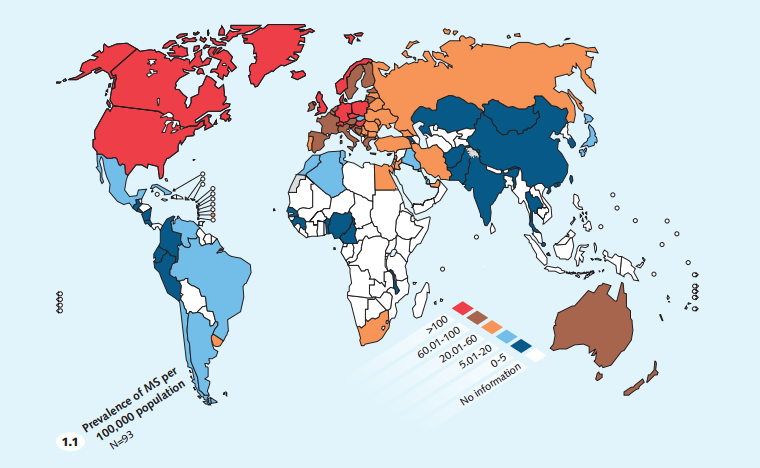
Multiple Sclerosis (MS) was once a rare disease that mainly affected Scandinavians or people who otherwise didn’t get much sunlight. But that has all changed. Its prevalence is accelerating wildly and sunlight is much less relevant than what you shove in your gob. If you’d rather not get MS then it is vital you avoid consuming the Omega-6 fats found in most processed foods.
Our central nervous system is our electrical wiring. If our brain wants to tell our fingers to move, an electrical signal is sent along the nervous system and the fingers move. Just like electrical cables nerve cells have an insulating cover (called myelin). Electrical signals travel much faster (and are much more certain to get to the destination) in insulated nerves than in non-insulated nerves.
Seventy percent of the insulation is fat and a fair chunk of that is polyunsaturated fat. Unfortunately this means that the insulation is prone to damage from oxidation. But not to worry, we have a perfectly good repair system. The cells which make myelin (called oligodendrocytes for those who want to get all technical) are very handy at continuously patching up any damage.
MS is disease caused by our immune system attacking and destroying the myelin insulation. This damage disrupts the ability of parts of the nervous system to communicate and it results in an array of symptoms which range from fatigue, physical incoordination, spasms, partial blindness as well as learning and memory problems (depending on which part of the nervous system is damaged).
Unfortunately people with MS can’t completely repair the damage being inflicted by their immune system and over time the cumulative damage means that the symptoms become progressively worse.
According to the World Health Organisation the biggest risk factors for MS are living in a place with little sunlight or a place exposed to processed food (the Western Diet). In the 1950s the biggest risk factor by a country mile was latitude, but as processed food has infiltrated the diet of more and more countries, those countries have caught up to the rates in countries with low sunlight exposure. In Iran for example the incidence rate quadrupled in just the two decades between 1989 and 2008. But there is (and always has been) plenty of sunlight there.
In countries exposed to the Western Diet for most of the last five decades (such as Australia), the number of new cases of the disease recorded per year (after adjusting for population increases) has also quadrupled. Make no mistake MS is an epidemic on the march.
Our immune system attacks parts of the body largely because the component (T regulatory cells or just TRegs) which is supposed to stop that happening becomes disabled. One of the most efficient ways to disable TRegs is to consume too much omega-6 fat.
The Western Diet is stuffed to the brim with Omega-6 fat courtesy of the steady replacement of animal fats with seed oils (such as canola, sunflower soybean etc). So every time you eat processed food or tuck into fried food you are taking on a massive dollop of omega-6 fat.
For example if you were drop a serving (20g) of Praise Mayonnaise onto your bacon and egg sarnie you would be consuming around 5 grams of Omega-6 fat (just from the mayo). That’s about three times what your body needs for the day (and that’s before we take into account the margarine, the bread, the grain fed bacon, the factory farmed egg or anything else you eat that day).
Sunshine (or, at least its ability to make us make Vitamin D) is a partial remedy to this problem because Vitamin D boosts the numbers of TRegs. This gives us a fighting chance at stopping our own immune system in its tracks. And that is why, before the advent of a seed oil filled diet, the exposure to sunlight, more or less determined your likelihood of having MS.
We aren’t born with a completely myelinated nervous system. It takes us about 20 years to finish the job. This means that when people move from a place with low rates of MS to places of high rates of MS (or the other way round), their age when they move is an important factor. If they are over 15 when they move they will have the same risk of developing MS as the place where they were born. If they are 10 or younger it will be the same as the place where they move to.
It’s likely that this strange age-related phenomenon is because of another characteristic of our seed oil filled diets. Overconsumption of omega-6 fats causes the body to enter a state called oxidative stress. This is where the highly reactive omega-6 fats overcome our anti-oxidant defences. Oxidative stress is known to be lethal to the cells which produce our nerve insulation.
It is therefore probable that constant exposure to omega-6 fats while a child is growing those very cells, will result in insulation which is not up to spec. And a weakened insulation makes them much more susceptible to the immune system attacks which will almost inevitably happen if they stay on that diet.
MS is a truly horrendous disease that is striking more people, younger. It is clear that the cause is the massive increase in the use of seed (vegetable) oils in our food. MS was once a disease that struck only susceptible people who were not exposed to enough sunlight. Seed oils are now ensuring it is something that all of us must fear.
If you have MS, I’m sorry. If you can stop eating seed oils (and get some Sun), it may help with symptoms. If you don’t have MS, stop eating seed oils (and get some Sun) and you will dramatically reduce your chances of getting it. If you have children, don’t let them anywhere near seed oils, ever, but especially not before they’re 20.
Graphic from: WHO – Atlas multiple sclerosis resources in the world 2008.
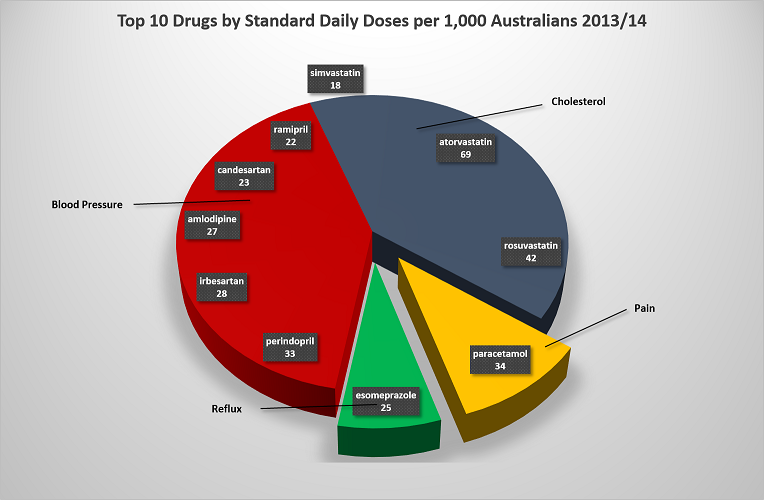
Last week the Australian Health Department published its annual hit parade of Australia’s most used drugs. It revealed that just two ‘diseases’ accounted for eight of the top 10 places, high cholesterol and high blood pressure.
Because the vast majority of drugs prescribed here are heavily subsidised by the taxpayer, the Federal Government keeps a very accurate tally of what our doctors are putting in our shopping bags.
This year’s top of the (pill) pops tells us that on any given day 32 out of every 100 men, women and children in Australia will be knocking back one of the pills in the top ten.
#1 with a bullet – Anti-hypertensives.
13.4 of those 32 people will be downing a pill for their blood pressure with their morning orange juice. They’ll probably be studiously avoiding salt as well on doctor’s orders.
The only problem is that research published just this week tells us the OJ is more likely to be causing the blood pressure problems than any amount of salt they might be consuming.
This confirms a long line of studies which have concluded that the fructose half of sugar is the cause of high blood pressure and not the salt.
#2 – Statins, the drug without a disease.
Riding hard on the heels of the blood pressure pills, 12.9 of those 32 people will be taking some sort of Statin, a drug that treats exactly nothing, but which is supposed to lower the risk of future heart attacks.
Statins are powerful drugs that alter the function of important liver enzymes, and the evidence suggests that the only class of people who benefit are younger men who’ve already had a heart attack.
The only people who should be given statins should be this very small group (and then only if their doctor feels the benefit outweighs the risk of diabetes and dementia).
#3 – Paracetemol
If this list is giving you a headache then you’ll likely be joining the 3.4 out of every hundred of us who will pop a Panadol today.
#4 – Reflux medication
Rounding out our list is a medication to treat heartburn and GERD (Gastro-Esophageal Reflux Disease). Just 2.5 in every 100 of us will be getting into those pills, but recent data tells us it a class of drugs with a big future.
GERD is likely to be caused by a combination of the obesity caused by eating too much sugar and the bacterial overgrowth caused by, yep you guessed it, eating too much sugar. It won’t come as too much of a surprise then to discover the percentage of the population suffering from GERD has significantly increased in the last two decades.
More than 1 in 10 Australians now suffer from the disease and almost 7 million scripts a year are written for the one drug (for GERD that makes the Top 10) alone. It is the fourth most expensive medicine funded by the Australian taxpayer (who shells out more than $200 million a year for it).
Taken together, the Top 10 list accounts for a serious chunk of Australia’s pharmaceutical budget. It’s a budget that is under constant pressure. And there are many unfunded drugs that don’t make the cut, not because they don’t work, but because too few people will benefit.
Instead we’re spending our precious drug dollars on massively overprescribed statins and drugs to treat diseases of sugar consumption (oh and headache pills). Wouldn’t it be better if we just stopped eating the sugar and listening to drug company marketing around statins?
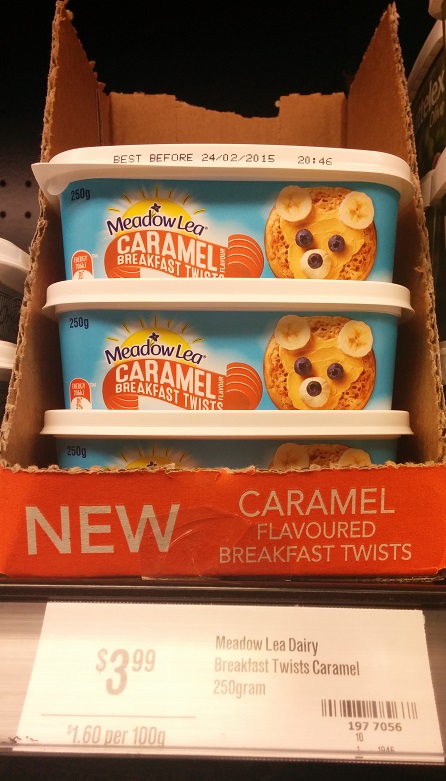
Just when you thought margarine was about as dangerous as any ‘food’ could get, Goodman Fielder have released their new range with added sugar.
That’s right, now you can get margarine with added sugar. And not just a smidge, one fifth of the product is sugar (sugar content ranges from 17.8% to 20.5% depending on the flavour).
The omega-6 fats which dominate ordinary margarine are implicated in (at least) osteoporosis, male infertility, rheumatoid arthritis, Parkinson’s disease, allergies, asthma, macular degeneration, impaired intelligence and cancer.
But now with twice as much sugar as an equivalent quantity of Coke, Meadow Lea Breakfast Twists put the unwary consumer on track for an even more spectacular array of chronic diseases including Type II Diabetes, Kidney Disease, Fatty Liver Disease, Heart Disease, Erectile Dysfunction and Alzheimer’s.
If I tried to think of a way to combine the very worst of a processed food diet in a single product, I don’t think I could do any better than this. Besides the obligatory preservatives, flavours and colours there’s really nothing in this product but seed oils and sugar (with a pinch of salt and a dash of ‘milk solids’).
Ingredients: Vegetable oils 45% (containing 36% Canola & Sunflower oil), water, sugar, salt, milk solids, emulsifiers (soy lecithin, 471), preservative (202), food acid (lactic), colour (beta-carotene), flavour, vitamins A & D.
But perhaps the very worst thing about this stuff is that it is being marketed to (and for) kids. The site proudly proclaims
“And because it’s been taste tested with kids, you know they will love it!”
This is especially appalling because the evidence is clear that many of the diseases associated with omega-6 fat consumption develop in childhood. Worse, the damage is cumulative and likely to be irreversible.
None of the research on the harm done by sugar and seed oils is a secret. No-one should ever eat margarine, but children especially should be kept as far away from it as possible. And yet, Goodman Fielder appear to have explicitly designed this product to make it more appealing to kids (by adding a ton of sugar).
It is despicable behaviour of the highest possible order and it should not be rewarded with commercial success. Please tell everyone you know to avoid this product like the bubonic plague.

A significant component of what makes us intelligent is created from our mother’s fat stores. Unfortunately the fats which dominate margarines and processed food stop that absorption happening and impair intelligence in children to a greater degree than was ever caused by lead. If you want your kids to be as smart as they can be then they (and you) need to immediately stop eating those fats.
About 10% of our brain is made from an Omega-3 fat called DHA (docosahexaenoic acid for the biochemists amongst us). We can make DHA from a simpler omega-3 fat called ALA (alpha-linolenic acid). That’s the form of omega-3 which exists in most of our food.
Unfortunately we are not very good at converting dietary omega-3 ALA into DHA. Less than half a percent of the ALA we consume ends up as DHA. This means that relying on mum to eat enough omega-3 ALA while she’s pregnant would be a disastrous strategy for baby brain building.
Luckily we have a plan. As soon as a woman reaches puberty her body starts storing up as much Omega-3 fat as it can. Uniquely among animals (because we are the only ones who need to build relatively gigantic brains), female humans store all that omega-3 ALA in a baby pantry located at the top of the legs and in the buttocks.
Unfortunately for girls who wish to become Supermodels, the body cannot tell the difference between the various sorts of fat, so it just stores all the fat it can find in the hope that enough of it will be the good stuff.
Since the point of storing the fat is to ensure there is enough (ALA to make) DHA to make a baby’s brain, the body will not easily let go of it. That is, until the third trimester of pregnancy. Then the floodgates are opened and the fat is released. Because brain construction doesn’t finish when a child is born, it’s also important that the supply of DHA continues after the baby is born. Breast milk (and now formula) contains large amounts of DHA. In total, 80% of the fat used in construction of a child’s brain comes from the mother’s stores (rather than her current diet). So perhaps the old saying should be ‘A moment on the lips, a lifetime on the hips in your child’s brain’
We know from animal studies that if there is not enough DHA, animals end up with brains that don’t have enough neurons, the cells that do all the work in our brains. That lack of basic circuitry in turn impairs the child’s development and intelligence. And it looks like the results hold in humans as well.
Just last month, a study in humans was able to show that the amount of DHA in breast milk was the strongest predictor of test performance across samples drawn from 28 OECD countries.
But before you start force-feeding teenage girls, mothers and kids fish oil tablets, you should know that there is a little twist in this tale. Omega-6 fats stop us using DHA to make us brainy. So it doesn’t matter how much Omega-3 you have if you also consume too much Omega-6.
Omega-6 fats are the dominant fat in seed oils (canola, soybean, grapeseed, corn, sunflower etc). These are the fats that margarine is made from. These are the fats which are now used in every packaged food on the supermarket shelf. And these are the foods in which every fried food is boiled. We now eat 10-20 times as much omega-6 fat as omega-3 fat.
Omega-6 fats compete with Omega-3 fats for the same enzymes. Critically one of those is the enzyme which turns garden variety omega-3 ALA into DHA. If we have equal amounts of omega-3 and omega-6 in our diet, just the right amount of DHA is created and all is good, but if we have too much omega-6, we fail to make enough DHA.
You might predict from that, that countries that eat a lot of seed oils loaded with omega-6 would tend not to do so well in tests and you’d be right. The researchers in the most recent study found that there was a very strong correlation between the amount of omega-6 in the diet and how poorly 15 year olds did on standard international benchmark tests.
This confirmed the findings of five previous human studies which showed that higher omega-6 intakes impaired cognition (made us dumb – translation provided in case you’ve been hitting the margarine). Indeed one 2011 study determined that the impairment was greater than the effect of lead!! (double exclamation points are well and truly warranted on that statement)
Just like omega-3 fats, omega-6 fats are stored in the baby pantry, ready to use when needed. So the fats used to construct a baby’s brain are not just the fats a woman is eating when she’s pregnant or breastfeeding. They are every fat she has stored since puberty (or since the last baby used them up). Babies being constructed today are having brains built from the fats used in processed food for the last 20 years.
We now use unleaded petrol because of the damage lead in petrol did to developing brains. If we want the next generation not to be ‘cognitively impaired’ by seed oils, we need to act now.
We need to ensure that (at the very least) young women are not consuming foods overloaded with omega-6 fats. This means no margarine, almost no processed food and no commercially fried food. In other words they need to eat real food and they need to do it now.
If they do this their children will be smart enough to thank them for it.
Image courtesy of Phaitoon at FreeDigitalPhotos.net
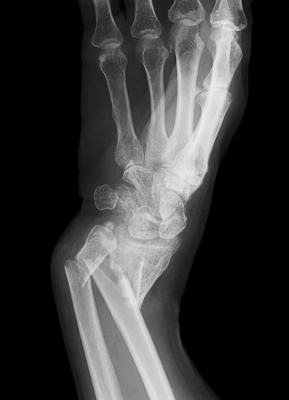
Scientists have known for more than a decade that the omega-6 fats contained in vegetable oils (like those used to manufacture margarine) degrade human bone density. Now new research has thrown light on how that happens and why anyone concerned about osteoporosis needs to immediately stop consuming them.
One in twenty Australians have osteoporosis (Greek for ‘porous bones’) and 1 in 4 have low bone density (the precursor to osteoporosis). The number of people affected is accelerating wildly. In the last 10 years the number of GP visits related to osteoporosis has doubled in Australia.
Our bones are not static lumps of rock. They are living tissue which constantly accumulate and dispose of minerals. Osteoporosis occurs when bones lose minerals, such as calcium, more quickly than the body can replace them. This causes a loss of bone thickness (bone density or mass).
As bones become thinner and less dense, even a minor bump or fall can cause a serious fracture. Unfortunately most people don’t know they have the disease until after they suffer a break. Eight out of ten cases are recorded in people over the age of 55 but the age of onset is becoming progressively younger.
Osteoporosis medicines work by making the cells that break down bone (osteoclasts) less active. This tips the balance towards accumulation of minerals by the cells that form bone (osteoblasts).
A long series of animal studies have clearly established that polyunsaturated fats are important drivers of the bone recycling process. We know that omega-3 polyunsaturates which dominate some fish oils, flax seeds and kelp help us build up bone density. While the omega-6 fats which dominate seed oils (like sunflower, soybean, canola, safflower and rice-bran) destroy bone density.
In 2005 researchers at the University of California confirmed that the same rules were at work in a large human population. In that study 1,532 people were observed for 4 years. The results were spectacularly consistent. The more omega-6 a person consumed (or the higher their omega-6 to omega-3 ratio), the lower their bone density was. It really was that black and white.
The results were independent of medication use, their BMI or the amount of exercise they did or didn’t do. This means that all the things which we are told affect our chances of getting osteoporosis were rendered irrelevant by just one thing, the amount of omega-6 fat in the diet.
Unfortunately (for our health) nobody in the Health Community wants to hear that they should stop telling people to eat seed oils, so there has been precious little publicity about that line of studies. That is, until bone density started mattering to people who breed animals for a living.
As we feed more and more of our farmed fish, diets which are high in omega-6 fats, they are becoming more and more fragile. It seems that just like humans (and rats). Their bones go to pot if we ramp up the omega-6.
This latest proof of the bone destroying power of omega-6 comes courtesy of an aquaculture study out of the Norwegian National Institute of Nutrition and Seafood Research. In that study, the scientists observed a rise in the level of activity of the enzyme that breaks down bone, in line with the rise in omega-6 concentrations.
We don’t know exactly how omega-6 works its destructive magic but the scientists suspect that it relates to the production of PGE2, the prostaglandin responsible for bone metabolism. We make PGE2 from omega-6 fats, but the presence of omega-3 fats stops it being produced. This is because omega-3 and omega-6 compete for the same enzymes. If we make just the right amount, everything is tickety-boo but if we make too much, say, because we have too much omega-6 and not enough omega-3, then we start breaking down our bones.
Every processed food on the supermarket shelves is loaded with omega-6 fats (in the form of seed oils). Every fried food has been boiled in omega-6 fats (seed oils again). Our National Heart Foundation actively encourages us to eat margarines brimming with omega-6 fats (yep, seed oils). And the charity responsible for advice about Osteoporosis doesn’t even mention the known link between omega-6 fats and the disease.
In this environment it is not strange that the number of people affected has doubled in just a decade, it’s a bloody miracle it hasn’t tripled. But stay tuned, at the rate we are increasing the consumption of omega-6 fats, there is much more pain to come.
Image courtesy of Boaz Yiftach at FreeDigitalPhotos.net

Australia has one of the highest equity, best performing Tertiary education systems in the world. Now the government wants to toss that model in the bin and copy a system which is comprehensively failing to deliver benefits for its students, employers or taxpayers. Please tell me we aren’t about to destroy our higher education system because our Education Minister really, really likes Americans.
Just like taxpayers in every developed country, Australian taxpayers help fund higher education with direct payments to Universities and low interest loans to students. We do that because the benefits to the country in having highly educated people generally outweigh the costs. And in Australia we get especially good value for money. We are one of only 5 OECD countries where public benefits (higher taxes and reduced welfare) are higher than the costs to the taxpayer.
When it comes to taxpayer contributions to higher education, Australia is the the 7th cheapest country in the OECD (just ahead of Columbia, the US, Japan, the UK, Korea and Chile). Here taxpayer funds cover just 45.6% of the cost of Tertiary education, way below the OECD average of 69.2%.
We may be cheap but our higher educators are kicking some pretty serious goals when it comes to the outcomes that matter. Our graduates have the 5th best literacy proficiency in the OECD (on par with the best in the world, Japan, the Netherlands, Finland and Sweden). We’re only 12th best in numeracy, but that is still well above the average for the OECD.
Even when it comes to research, our bargain basement Universities are up with the big spenders. We are second only to Sweden in the percentage of GDP devoted to University R&D. And we are spending proportionately three times as much as our neighbours in the cheap seats, Chile.
We manage all of that with one of the most accessible and equitable university sectors on the planet. Here, 17% of school leavers entering Higher Education are from the lowest quartile of the population. And that rate has been steadily climbing, up from 15.7% in 2006. In the US, the trend is very much in the opposite direction, dropping from 12% in 1970 to just 7% now.
We have a cheap-as-chips, high performing tertiary education system, but now the government wants to make us even cheaper by shaving a fifth ($1.7 billion a year) off the taxpayer contribution. The only way to do that and still have a higher education system is to ask the students to contribute even more.
If the funding cuts were the only changes being proposed then we would justifiably fret about whether taxpayers really would get monkeys if we pay (less) peanuts. Yes, it would cost the individual more to get the education they want and yes, that may impact on the number of people likely to want to do the things Australia needed them to do. And yes that may result in lower tax collections, more debt and more welfare.
But none of it would be immediately catastrophic. And any damage could be easily reversed if it started to look ugly. If only the same could be said for the other little change the Minister for Education wants to make.
As a bit of a sweetener for the G8 (Group of Eight largest universities in the country), the Education Minister has decided to allow tertiary institutions to charge whatever they like and the government will still pick up its part of the bill. And it’s worked. Instead of G8 Vice-Chancellors baying for the Minister’s blood over the huge cuts, they are thinking of electing him Pope (or something).
The Minister has done this because he wants our University system to be market driven just like the US. He feels that is the only way to get our Universities in the top 100 in the world (as determined by just about everything but the quality of the students they produce). And if that’s the goal then copying the US is probably as good a way as any of doing it. It’s just a pity it will destroy Australia’s high equity, high student outcome, tertiary education system in the process.
Just like the privatised US Health system the privatised US higher education system is a case study in market failure. Even though US citizens and taxpayers spend more on universities than any other country, the US comes in 15th out of 34 OECD countries when it comes to educational attainment.
It is a system divided into outrageously expensive premium universities (which is the prize our G8 are eyeing off) and a large swath of cheap back to basics institutions. Neither the expensive few, nor the rest, produce desirable outcomes for the student population.
American college graduate academic performance is abysmal and sliding fast. An Australian graduate is almost twice as likely to get a job as their US counterpart. But it will personally cost the US graduate 4 times as much and the US taxpayer 50% more.
This is what happens when you destroy equity in an education system. Do we really want to copy that?
First published in The Courier Mail
Image courtesy of patpitchaya at FreeDigitalPhotos.net

School uniforms increase equity and decrease bullying. But school choice is leading to significant upscaling of uniform costs at exactly the same time as the government removes financial assistance aimed at defraying those costs. The result will be sharply less access to our education system for those who depend on it the most.
I served my time at primary school in a selection of government schools in Western Queensland in the 1970s. It was the dawn of “school choice”. The federal government was yet to dabble in funding private education so almost everybody went to either their local public or their local Catholic. And there wasn’t a lot of difference between the two (except the government schools tended to have more money).
We all wore pretty much the same uniform. Cotton button-up shirts for the boys and checked dresses for the girls, khaki for the public kids and blue for the Catholics. The only distinguishing feature was a school badge which was usually pinned to the collar. It was a simple, cheap uniform that could be bought from any supermarket.
Roll forward four decades and much has changed. We have many more choices about where we send our kids to school. This marketisation of schooling (school choice) is increasingly driving schools to see the school uniform as a branding exercise. And it’s not just the swanky independent schools giving their uniforms a zhoosh. Increasingly public schools, especially those which become “independent” are using their uniforms as a weapon in the marketing wars against each other and their private competitors.
Blazers, ties, cotton shirts and formal school dresses are starting to be part of the required “kit” and all of it is intentionally different to anything you can pick up at Kmart. This inevitably and significantly increases the costs of those uniforms.
Suddenly uniforms are no longer a way of keeping us, well, uniform. We are no longer on an even playing field. There are those who can afford the gear and those who can’t. And those who can’t, frequently choose not to attend school at all. As Julia Gillard once said (as part of announcing subsidies for school uniforms) “having a uniform helps undercut the kind of unhealthy competition we can see at schools to have the latest, most expensive, fashionable gear”.
Most Australian state governments maintain schemes aimed at defraying the costs of education incidentals (such as uniforms) for those who need it most. In Victoria, the scheme is called the Education Maintenance Allowance. It pays up to $300 per child a year to help with education costs. In 2014 the allowance was paid to a quarter of the state’s schoolchildren (more than 208,000 kids). Next year it will be paid to nobody because the state government has killed the allowance. In 2016, the Feds will join the party by cancelling the Schoolkids Bonus, a similar scheme worth up to $842 per student a year.
In place of its allowance the Victorian Government has implemented a scheme of increased funding for schools in disadvantaged areas but the disbursement of the money is entirely at the discretion of the school principal. It turns an administrative entitlement into a degrading demonstration of need at the school gate (not to mention competition for that terrific new professional development course, the principal had their eye on). Worse than that, it will completely exclude disadvantaged children who happen to attend schools in more advantaged areas. There will be no replacement for the Schoolkids Bonus.
The OECD has closely examined the relationship between the equity of a country’s education system and its performance, and decided: “The evidence is conclusive: equity in education pays off. The highest performing education systems across OECD countries are those that combine high quality and equity.”
When the OECD ranked the equity of the various education systems in 2007, Australia came in just a little below average (lagging behind Italy and Switzerland but ahead of France, the United States and the United Kingdom). And as the OECD suggests might happen, that result seemed to predict our plummeting academic ranking. Each new round of international testing tells us we are falling further and further behind.
You don’t need to have won the Nobel Prize in economics to calculate that, at a time when parents need more help than ever with uniform costs, pulling the economic rug from under them is likely to have dire consequences for many families. And the destruction in equity that will follow, will have even more disastrous consequences for the performance of all of our children, uniformly.
First published in The Age

Sydney, Australia (10 October 2014): Nestlé Australia announced today that in an unprecedented achievement for the category in Australia, its popular Killer Python confectionery will carry the Heart Foundation Tick in 2015.
This is the first time that confectionery has earned the Heart Foundation Tick. “We don’t know why we didn’t think of this before,” said Mr Bill Wonka, Regional Director, Nestle Australia. “But once we took a close look at the Heart Foundation Tick criteria, we knew that the Killer Python could become a key part of our promise to deliver superior nutrition to Australian families.
“All we had to do was cut the little buggers in half. Then suddenly we were under the calorie limit. They already had no fat and the Heart Foundation doesn’t look at sugar. From today, consumers have a healthier confectionery option that means they don’t sacrifice on taste. It’s a win for everyone.” he said.
“We are now looking closely at the rest of our confectionary lines and a number of beloved brands are currently undergoing renovations to meet the Heart Foundation’s strict nutrient criteria. Keep an eye out for Chicos with added fibre in the new year.”
“We are proud that Nestle is now carrying the Heart Foundation Tick in a confectionery line. Nestle Australia should be congratulated on their commitment to an extensive reformulation programme that provides Australian families with more healthier choices at snack time,” said a spokesperson for the National Heart Foundation.
“For more than two decades the Tick has been successfully challenging food companies to produce healthier foods. Now, we are challenging more confectionery makers to match the commitment of Nestle Australia.”
Reaction from the public has been mixed. Clive Parma from Canberra was pleased that the Pythons now had the tick “I was sick of feeling guilty every time I sucked down their chewy goodness,” he said, “Now they are approved by the Heart Foundation, I know they must be doing me good, even if I do have to buy twice as many.”
Health professionals also welcomed the news. “A 10 year old can now run off a Heart Foundation approved Killer Python in around 30 minutes,” said dietitian Ms Pixie Golightly, “With the old junk food Pythons, it would have taken almost an hour,”
But on social media the mood has been less positive. “Not fun for the kids at all any more,” wailed Verity Smythe-Jones on Allen’s Facebook page. “my kids won’t touch health food – as soon as they see that tick they’ll avoid them – what chance do I have of getting them to eat the new healthy pythons?” she wrote
Nestle expects the new Heart Foundation approved Treat Sized Pythons to be available shortly.
Note: This is satire – nothing about this piece is true (no matter how close to the truth it might seem)
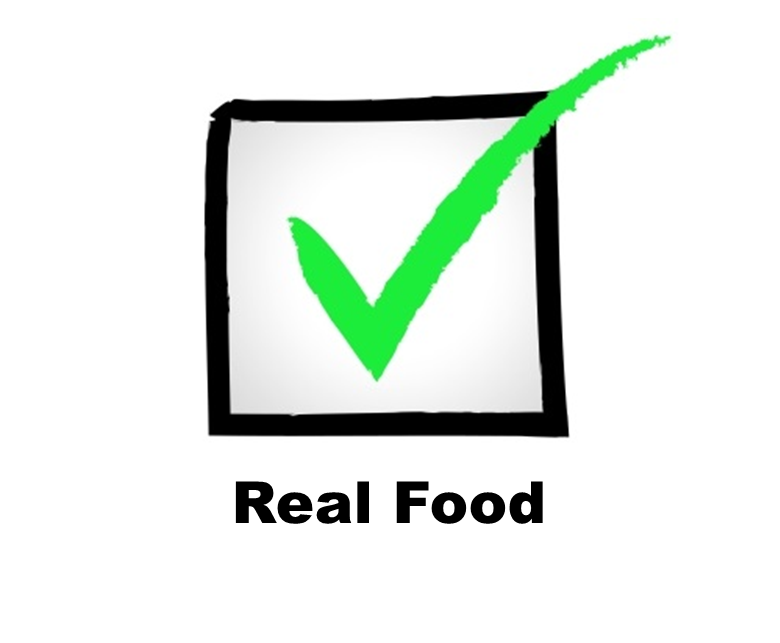
Most modern deaths are caused by diseases which barely affected anybody 200 years ago. And the science says that between them, sugar and seed oils are responsible for almost all of those deaths.
The twin innovations of commercial sugar production (which made food addictive) and seed oil manufacture (which made food cheap to construct) has completely transformed our food supply in that timeframe.
Almost every packaged food now contains significant quantities of sugar or seed oil or (more usually) both. But far worse than that, it almost impossible to tell from that packaging (other than the fact that there is packaging, that is) whether a given food is safe or not.
I propose a simple way to tell the difference. Introducing, the Real Food Tick of Approval. The rules are very simple:
- All whole food qualifies for the Tick
- Any packaged food which contains more than 1.5 grams of fructose per 100 g does not qualify
- Any drink which contains fructose (at all) does not qualify
- Any packaged food or drink which contains more than 1.5 grams of Omega-6 fat per 100 g does not qualify
- All other food qualifies for the Tick
To see how this works in practice, check out my free, foods database. In it I have applied these rules.
The database is not perfect, it is using an automated formula (which tries to use fibre content to guess which are whole foods) to do the coding. This means it doesn’t properly take account of Rule #1 (at this stage), so there will be obvious errors – but you get the gist.
Most things coloured green would get the Real Food Tick. And the application of a little nouse would eliminate the obvious exceptions (for example Apricots in Intense Sweetened Liquid)
Most of those coloured yellow or red would not qualify. But there are whole foods which are particularly high in fructose (for example a Pink Lady apple) or Omega-6 (for example Peanuts).
Neither of these whole foods are coloured green but Rule #1 says they should qualify. With those I would suggest, they still deserve the Tick (because they are whole foods), but it should be a yellow tick rather than a green one, merely to indicate that more than one serving of these foods should not be consumed.
I’d love to hear your thoughts (in the comments below) on the proposed Real Food Tick.
Graphic based on an Image courtesy of Stuart Miles at FreeDigitalPhotos.net











Recent Comments